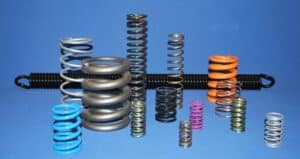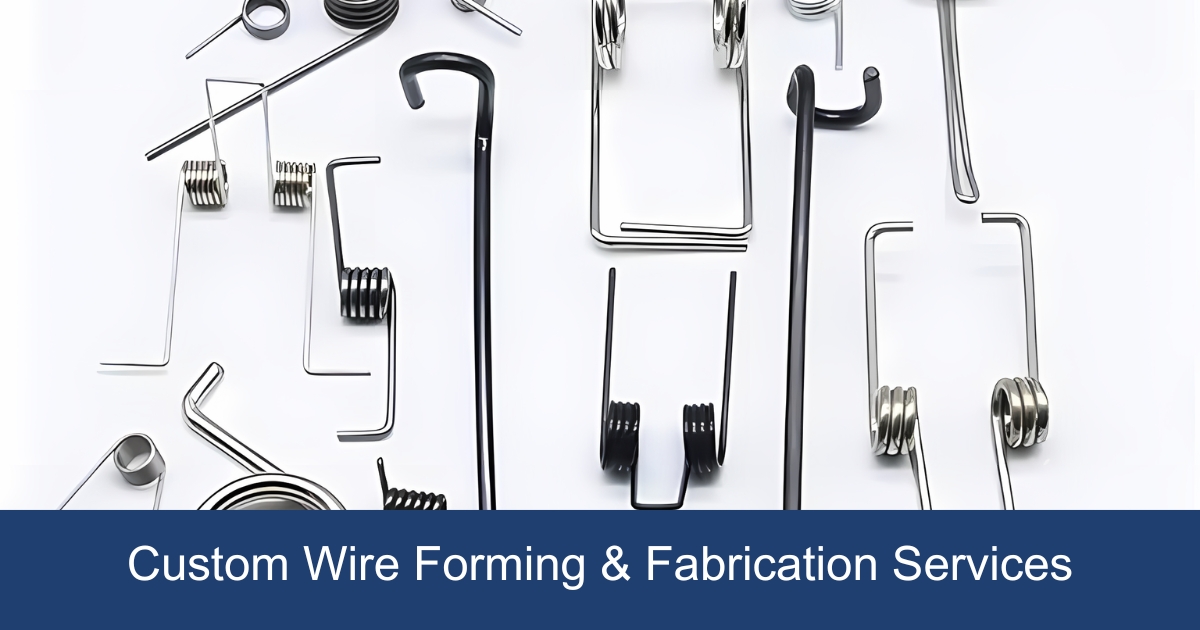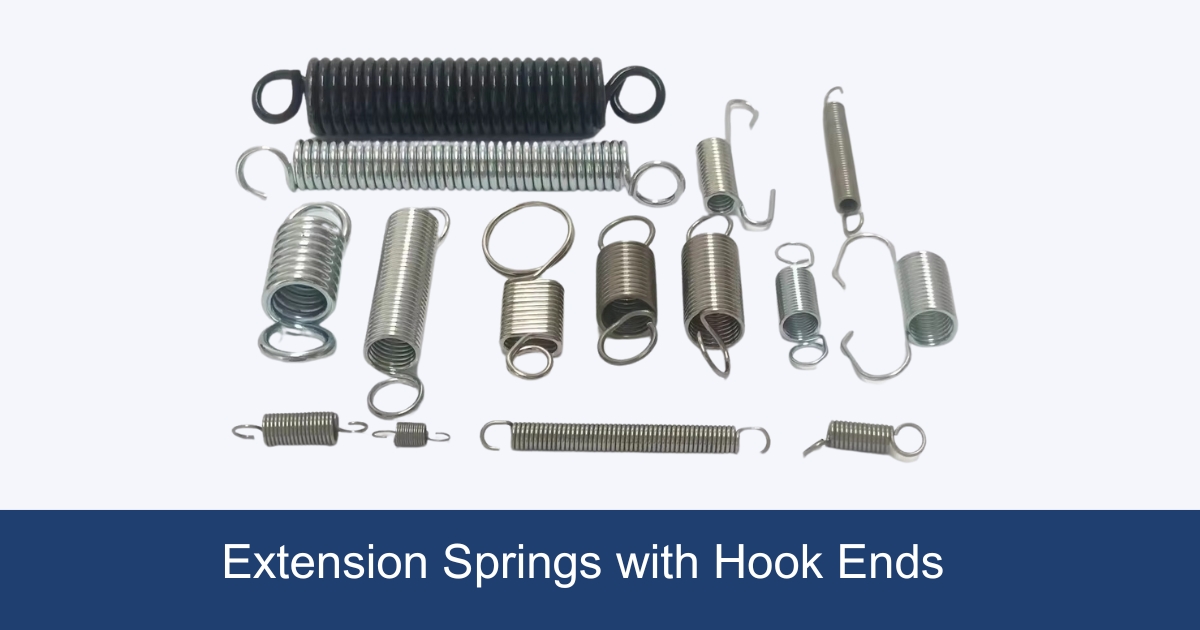Delve into the world of Spring Finishing and Coating Options through this guide, unlocking the secrets to significantly enhancing both the durability and visual appeal of your springs. This exploration offers invaluable insights into customizing your spring finishes for optimal performance and aesthetic excellence.
What is the best coating for custom springs?
One of the standout choices for coating springs is zinc phosphate. This coating is renowned for its exceptional ability to offer corrosion resistance, significantly enhancing the durability of the spring in harsh environments. Beyond its protective capabilities, zinc phosphate coating also imparts excellent lubricity. This characteristic is crucial in reducing friction and wear between spring components, which is vital in applications where the spring is subject to constant movement or load.
However, identifying the “best” coating for springs is a complex matter, as the ideal choice varies widely depending on several factors, including the application, environment, material, and specific performance requirements of the spring. Rather than pinpointing a single, superior coating, it’s more practical to explore how different coatings serve diverse needs effectively. By examining various coating types, we can appreciate their unique benefits and determine which might be best suited for specific scenarios.
Objectives of Spring Finishing and Coating
The objectives of spring finishing and coating include:
- Protection Against Corrosion and Environmental Factors Finishes and coatings protect springs from corrosion by creating a barrier against moisture, chemicals, and salts, extending their lifespan.
- Improvement of Mechanical and Physical Properties Coatings enhance springs’ strength and elasticity, enabling them to withstand higher stresses without deforming, crucial for demanding applications.
- Enhancement of Aesthetic Appearance Aesthetic finishes improve the look of springs, allowing for customization to match product design or brand identities, important in consumer-facing products.
- Reduction of Friction and Wear Coatings like Teflon reduce friction between springs and contacting surfaces, minimizing wear and prolonging the life of both the spring and the device it’s part of.
- Compliance with Industry Standards and Regulations
Various industries have specific standards and regulations governing the materials and finishes that can be used in their products. For example, springs used in medical devices or food processing equipment must adhere to stringent hygiene and safety standards. Coatings and finishes can help meet these requirements by providing surfaces that are easy to clean and resistant to bacterial growth.
Types of Spring Finishes and Coatings
The types of spring finishes and coatings include a variety of options that offer different benefits for protecting springs and enhancing their performance. Some common types of finishes and coatings for springs are:
1. Electroplating
Electroplating involves covering the spring with a thin layer of metal such as nickel, zinc, or chromium through an electrochemical process. This method enhances the spring’s corrosion resistance, electrical conductivity, and overall appearance.
- Nickel: Offers a balance between corrosion resistance and cost-effectiveness. It’s known for its lustrous finish and is commonly used in automotive and consumer electronics.
- Zinc: Highly effective at preventing rust. Zinc coatings are relatively inexpensive and provide a decent level of durability against corrosive substances.
- Chromium: Provides the highest level of corrosion resistance and a shiny, attractive finish. However, it’s more costly than nickel and zinc and is used in applications requiring superior aesthetic qualities and durability, such as in the automotive industry.
Each of these electroplating options has its trade-offs between cost, corrosion resistance, and aesthetic appeal, making them suitable for different applications.
2. Powder Coating
Powder coating is a process where a powder material is sprayed onto the spring and then cured under heat to form a hard coat. This method offers excellent uniformity and thickness control, making it ideal for achieving a durable and high-quality finish.
- Advantages: Powder coatings are known for their superior durability, resistance to chipping, scratching, fading, and wearing compared to traditional paint finishes. They’re available in a wide range of colors and textures, and because they’re solvent-free, they’re more environmentally friendly.
3. Painting
Painting is a straightforward approach where liquid paint is applied to the spring, either through spraying or dipping, followed by curing.
- Types of Paints: Options include acrylics, epoxies, and urethanes, each offering different levels of durability, chemical resistance, and finish.
- Application Methods: Spraying is common for complex geometries, ensuring even coverage, while dipping might be used for simpler shapes or bulk processing.
Though not as durable as powder coating, painting allows for a wide color selection and is cost-effective for certain applications.
4. Anodizing (for Aluminum Springs)
Anodizing involves enhancing the natural oxide layer of aluminum springs, increasing corrosion resistance and surface hardness.
- Process and Benefits: The process uses an electrolytic treatment to thicken the aluminum’s oxide layer, making it more resistant to corrosion and wear. Anodized finishes can also provide better adhesion for glues and paint if further customization is needed. The process offers the added benefit of giving the spring a colored finish that can be tailored to specific aesthetic requirements.
5. Passivation (for Stainless Steel Springs)
Passivation is a treatment applied to stainless steel to remove free iron from the surface and enhance the natural corrosion-resistant chromium oxide layer.
- Process and Importance: Using acid solutions, passivation cleans and provides a more uniform and inert surface. This is critical in applications where corrosion resistance is paramount, such as in medical devices or food processing equipment.
Each finishing and coating option is tailored to the specific needs of the spring’s application, considering factors like environmental exposure, mechanical stress, and industry standards.
Table Summary of Spring Finishes and Coatings
| Finish/Coating Type | Materials | Advantages | Ideal Applications |
|---|---|---|---|
| Electroplating | Nickel, Zinc, Chromium | Corrosion resistance, aesthetic appeal | Automotive, electronics |
| Powder Coating | Various polymers | Durability, wide color range, environmental friendliness | Industrial, consumer products |
| Painting | Acrylics, Epoxies, Urethanes | Cost-effective, wide color selection | General use, decorative |
| Anodizing | Aluminum | Increased corrosion resistance, customizable color | Aerospace, consumer electronics |
| Passivation | Stainless Steel | Enhanced corrosion resistance | Medical, food processing |
Additional Coating Choices for custom springs
Teflon, PTFE, or Other Polymer Coatings
Teflon and PTFE coatings are widely recognized for their exceptional non-stick properties, but their benefits extend far into the realm of spring coatings. These polymer-based coatings provide excellent chemical resistance, reduce friction, and can withstand a wide range of temperatures, making them ideal for springs used in harsh environments.
- Applications: These coatings are particularly useful in the automotive, food processing, and pharmaceutical industries, where non-reactivity and cleanliness are paramount. In automotive applications, they reduce noise and increase the lifespan of springs under the hood by minimizing wear.
- Performance Benefits: The low coefficient of friction and high resistance to corrosion ensure that springs function smoothly and last longer, even in challenging conditions. These coatings also exhibit excellent dielectric properties, making them suitable for electrical insulation applications.
Galvanization
Galvanization involves coating steel or iron with a layer of zinc to protect against corrosion. There are two primary methods: hot-dip galvanization and electro-galvanization, each offering distinct advantages.
- Hot-Dip Galvanization: In this process, the spring is dipped into molten zinc, creating a thick, durable coating. It’s known for its superior corrosion resistance, making it suitable for outdoor or industrial applications where the springs are exposed to harsh conditions.
- Electro-Galvanization: This method uses an electrical current to apply zinc coating. The resulting layer is thinner than hot-dip galvanization, offering a smoother finish. It’s ideal for applications requiring a good balance between corrosion resistance and aesthetic appeal, such as in consumer electronics.
Black Oxide Coating
Black oxide is a conversion coating for ferrous metals that provides minimal protection against corrosion but is used primarily for its aesthetic appeal and slight increase in resistance to wear.
- Process: The process involves immersing the spring in a solution of caustic soda and oxidizing salts, which converts the surface of the metal into magnetite (Fe3O4).
- Specific Use Cases: Black oxide coating is often used in applications where low reflectivity and minimal dimensional changes are crucial. It’s common in firearms, automotive parts, and precision tools. While it does not significantly enhance corrosion resistance, it can be used in conjunction with oiling or waxing for added protection.
Factors Influencing the Coating Choice of springs
Selecting the right finishing and coating for springs is a nuanced process that hinges on a variety of factors. Understanding these criteria is crucial for engineers and manufacturers to ensure that the chosen finishing method aligns with the application’s needs, environmental conditions, and economic considerations. Let’s explore these criteria in detail.
Environmental Conditions
The environment in which a spring operates can drastically affect its performance and lifespan. Factors such as humidity, saltwater exposure, and presence of chemicals or corrosive substances play a significant role in determining the appropriate coating. For instance, springs used in marine applications or in areas with high salt concentration require finishes like galvanization or stainless steel passivation to resist corrosion effectively. Similarly, springs in industrial settings with exposure to chemicals might benefit from polymer coatings like Teflon or PTFE for their chemical inertness and protective qualities.
Mechanical Requirements
The mechanical demands on a spring, including friction, wear resistance, and load-bearing capacity, significantly influence the choice of coating. High friction environments necessitate coatings that reduce surface friction, like Teflon, to minimize wear and extend the spring’s operational life. In applications where springs are under constant stress or load, finishes that enhance the material’s fatigue resistance, such as certain types of electroplating, can be critical for preventing premature failure.
Material Compatibility
Not all coatings are suitable for every spring material. The compatibility between the spring material and the chosen finish or coating is essential for ensuring not only the effectiveness of the protection but also the integrity of the spring itself. For example, aluminum springs benefit from anodizing, which enhances their natural oxide layer, whereas stainless steel springs might require passivation to maximize their corrosion resistance. Understanding the material properties and how they interact with different coatings is key to selecting the most appropriate finish.
Industry Application of springs
The intended use of the spring plays a significant role in coating selection. High-temperature environments might necessitate heat-resistant coatings, while springs used in medical devices require biocompatible finishes.
Cost Considerations and Economic Efficiency
Finally, the cost of applying a specific finish or coating and its impact on the overall manufacturing process cannot be overlooked. While some coatings offer superior protection or performance benefits, they may also come with a higher price tag and more complex application requirements. Balancing the cost against the expected lifespan, maintenance needs, and performance improvements is crucial for making economically efficient decisions that do not compromise on quality.
Testing and Performance of springs
The Rigorous Testing Process
Testing in custom spring manufacturing is not a one-size-fits-all procedure but a comprehensive series of evaluations tailored to specific coatings and their intended applications. These tests might include:
- Salt Spray Testing: To measure corrosion resistance, especially for springs destined for harsh environments.
- Coating Thickness Measurements: Ensuring uniform application to meet both performance specs and aesthetic requirements.
- Adhesion Tests: Critical for evaluating the durability of the coating under stress.
- Wear Resistance: For applications where springs are in constant motion or under heavy loads, assessing how well the coating can withstand wear is essential.
Performance Evaluation
The performance of coated springs is closely monitored through these tests, with a focus on:
- Longevity: How the coating contributes to the spring’s overall lifespan.
- Environmental Resistance: Assessing how well the coating protects the spring against elements such as moisture, UV light, and corrosive chemicals.
- Mechanical Performance: Evaluating any impact the coating may have on the spring’s tensile strength, compression, and elasticity.
Tailoring to Custom Needs
The beauty of custom spring manufacturing lies in its ability to meet unique specifications and challenges. Whether it’s a spring designed for aerospace, automotive, medical, or consumer electronics applications, the choice of finishing and coating is critical. Custom spring manufacturers utilize the insights gained from rigorous testing to recommend the most suitable finishes that ensure optimal performance in the specific conditions the spring will face.
Incorporating Key Considerations
- Application-Specific Requirements: Understanding the operational environment and mechanical demands helps in selecting a coating that offers the best protection and performance.
- Material Compatibility: The spring material plays a significant role in determining the suitable coating process, influencing both the application method and the potential performance outcomes.
- Industry Standards: Compliance with industry-specific standards and regulations ensures that the springs not only perform well but also meet safety and environmental requirements.
Conclusion
Choosing the right finishing and coating for your springs is crucial to ensure their longevity, functionality, and reliability across various applications. With options like zinc phosphate offering excellent corrosion resistance and lubricity, it’s essential to partner with an expert in custom spring manufacturing.
At Zigoal, we specialize in providing high-quality, customized spring solutions tailored to meet your specific needs. Reach out to Zigoal today, and let us enhance the performance and lifespan of your springs with our expert finishing and coating options.




